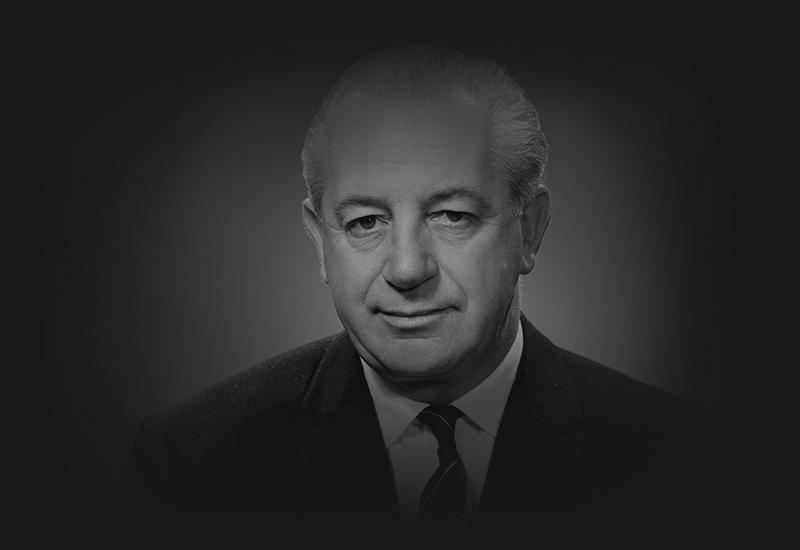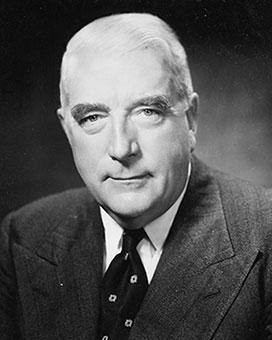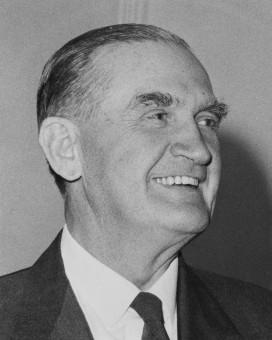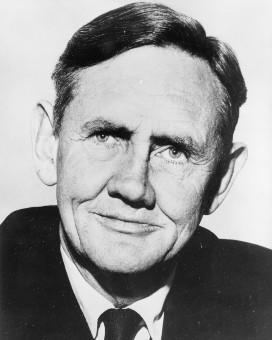Harold Edward Holt’s first ministry, sworn in on 26 January 1966, was the Menzies' ministry plus 2 new members. Holt had an inner Cabinet of 12, and an outer ministry of 13. The inner group had 8 Liberals in addition to Holt: William McMahon (replacing Holt as Treasurer), Paul Hasluck (External Affairs), Allen Fairhall (Defence), Senator Denham Henty (Supply), Alan Hulme (Postmaster-General), David Fairbairn (National Development), John Gorton (Works) and Leslie Bury (Labour and National Service). 3 Country Party ministers were in the inner group: leader and deputy Prime Minister John McEwen (Trade), Charles Adermann (Primary Industry) and Cec Barnes (Territories).
The outer ministry had ten Liberals: 2 newcomers, Annabelle Rankin (Housing) and Malcolm Fraser (Army), and Gordon Freeth (Shipping and Transport), Hubert Opperman (Immigration), Reg Swartz (Civil Aviation), Billy Snedden (Attorney-General), Jim Forbes (Health), Fred Chaney (Navy), Peter Howson (Air) and Senator Kenneth Anderson (Customs). The 3 Country Party members of the outer ministry were Doug Anthony (Interior), Ian Sinclair (Social Services) and Senator Gerald McKellar (Repatriation).
Holt’s Cabinet style was very different from his predecessor’s – where Robert Menzies had presided, Holt chaired. This was no surprise to Cabinet, as most ministers had been Holt’s colleagues for a decade or more. But Australian voters in their 20s and 30s – indeed everyone who had arrived by birth or boat since 1949 – had known no Prime Minister but Menzies.
The change in Australia’s head of government received maximum press coverage. The focus, inevitably, was on the obvious differences between the ‘old’ Menzies and the man he had always referred to as ‘young Holt’. Holt’s physical fitness and informality, his public persona and his smooth embrace of the fashion and style of the times made him seem much younger than his 57 years. The new Prime Minister did not avoid waiting press by using private side doors to Parliament House. Holt bounded up the front steps to deal with ‘door-stop’ questions and held weekly press conferences, though his ‘verbal fumbles’ sometimes spoiled the effect. Unlike Menzies, Holt was no great orator, but neither was Leader of the Opposition Arthur Calwell. So in Holt’s first year in Menzies’ shoes, this inadequacy was rarely noticed. Holt was the first Prime Minister to employ a speechwriter, Keith Sinclair, former editor of the Melbourne Age.
Australian citizenship
Neither non-British migration, nor the removal of the constitutional references to Indigenous people, were policies that characterised Holt’s outlook and parliamentary career. But during his term as Prime Minister, 2 giant steps in reshaping Australian citizenship were taken.
One of the achievements ascribed to the Holt government is the gradual dismantling of the ‘White Australia’ policy. Holt’s first prime ministerial statement announced the relaxation of restrictions that had blocked the entry of non-European migrants for 65 years. The Migration Act 1966 increased access to migrants other than those from Europe, including refugees fleeing Vietnam.
On 27 May 1967, another giant step towards the definition of Australian citizenship was taken when Australians overwhelmingly answered ‘yes’ to removing the discriminatory clause in Australia’s Constitution under which Aboriginal people were not counted in the census, and in changing the Constitution so that the Commonwealth parliament was empowered to legislate for Indigenous people.
An Australasian neighbourhood
In late January 1966, the Holts welcomed Prince Charles to Australia, to begin a year at ‘Timbertop’ school in Geelong, Victoria. The following month, they welcomed British Minister for Defence Denis Healey, US Vice-President Hubert Humphrey and Thai Prime Minister Thanom Kittikachorn. The January arrival of Australia’s future head of state might have been a keynote of the Menzies era, but the 3 February visits of foreign heads of state reflected the concerns of Holt’s term as Prime Minister.
The British Defence Minister was in Australia to discuss the impact on Australia of British withdrawal from Southeast Asia. Britain’s 1966 announcement of the end of a British presence in Malaya, and in all other posts east of the Suez Canal, also ended an era in Australian foreign policy. The visit of the US Vice-President and of the Thai Prime Minister clearly indicated its future direction.
The travel diaries kept by Holt and by Zara Holt, who accompanied him on almost all official trips, provide evidence of the determined development of relationships with Australia’s Asian neighbours. From 28 March to 9 April 1966, Holt travelled through South East Asia, conferring with government leaders and meeting Australian military and diplomatic personnel in Singapore, Saigon, Bangkok, Kuala Lumpur, Malacca, Tenedak, Butterworth and Sarawak.
A year later, Holt undertook an equally gruelling schedule on an official trip that included East Asia, with top-level meetings in Singapore, Cambodia, Laos, Hong Kong, Taiwan and South Korea. His decision to locate an Australian embassy in Taiwan demonstrated the direction of Australia’s Asian policy, particularly in the light of the potential effects on future relations with the Communist government of mainland China.
In between their ‘neighbourhood’ travels, the Holts hosted visits in return. The most controversial of these was the visit of South Vietnamese leader Air Vice Marshal Nguyen Cao Ky and Mrs Ky in January 1967. In his very first prime ministerial statement 12 months before, Holt had announced an increased Australian commitment, including national service conscripts, to support the United States in the war against Communist North Vietnam. Holt’s expansion of personnel from the initial 1500 of April 1965, to over 8000 in October 1967, met with a substantial, voluble and at times violent public opposition in Australia.
All the way
Although the Holts enthusiastically shared the Menzies’ relish for opportunities to visit the United Kingdom, the most important relationship-building exchanges were with the United States. Nevertheless, the Holts visited England in the northern summer in 1966 and 1967, and attended functions at Buckingham Palace and weekends at Chequers with Prime Minister Harold Wilson. On the 1967 visit, Holt received the Companion of Honour (CH) from Queen Elizabeth.
But it was Harold Holt’s ‘most spectacular friendship’ with US President Lyndon Johnson that indicates the importance for Australia of the relationship with the United States in 1966 and 1967. Holt had first met Lyndon Johnson in Melbourne during 1942. More than 20 years later, both men had become the leaders of their respective nations, and Holt met with President Johnson on a visit to Washington in July 1966, en route to England. At that meeting, Holt picked up the Democratic Party’s campaign slogan ‘All the way with LBJ’. His impromptu addition of the slogan to the text of his remarks on the White House lawn immediately intensified Australian opposition to the war in Vietnam. While the Holts were in London after that first meeting, Johnson invited Holt back to Washington for further talks. Then, 2 months later, the Johnsons were prime ministerial guests in Australia, marking the first official visit by a US President. This historic and whirlwind trip of 20–23 October 1966 covered Canberra, Melbourne, Sydney, Brisbane and Townsville. The last stop was a sentimental one – Johnson had been among US Navy personnel stationed in Townsville during World War II. It was also a strategic one – Townsville was Australia’s major northern Royal Australian Air Force (RAAF) base.
The presidential visit, immediately before Holt and Johnson attended the Manila ‘7-nation’ conference on Vietnam, and the federal election campaign soon after, were the focus for large anti-Vietnam war demonstrations. The reality of the alliance with the United States, nonetheless, brought support for the Holt government and an increased majority at the November election.
6 months later, when the Holts travelled to London via Ottawa for Expo ‘67, Washington meetings were first on the program. On the return journey, they stayed with the Johnsons at the presidential summer resort, Camp David, in Maryland. The ease and compatibility of the 2 men was both a sign and a reinforcement of the strategic alliance Australia sought with the United States. The perception that compatibility with the United States was an imperative for Australia was a key principle of Australian diplomacy in the Vietnam years.
Signs of the times
If a dominant feature of Holt’s term was the shift to an ‘Australasian’ rather than a British Commonwealth emphasis, the war in Vietnam marked another sign of the times. Perhaps because television was among the tools of new political dissidence, the Vietnam moratorium movement grew rapidly in Australia. Early in Holt’s term, protesters made the March 1966 by-election for Menzies’ seat of Kooyong one of the most rowdy campaigns in years.
Australia’s currency change was another sign of the times. One of Holt’s first tasks as Prime Minister was the conversion to an Australian decimal currency on 14 February 1966. The initial planning of the conversion had been his first task as Treasurer 6 years before. Such an everyday, but extensive, change was characteristic of Holt’s term of office. This period was seen then, as now, as a time for dusting off the old and welcoming the new, for shaping the new styles of the ‘swinging sixties’.
Among the more serious shifts facing Commonwealth countries were the changing world market and the geopolitical shifts in spheres of influence. Perhaps even more than Britain’s defence withdrawal from Australasia, Britain’s entry into common market arrangements with Europe demanded radical policy reappraisal. The effect on Commonwealth countries of the United Kingdom’s bid to join the European Economic Community had been a focus of Holt’s 1961 overseas tour as Treasurer. By the end of the 1960s, the ‘imperial preference’ trade and tariff negotiations of Australia’s first half-century were dead as new market alliances developed.
Political relations were changing as well. In the 1940s, the Empire had become the Commonwealth. In the 1960s, ties within the Commonwealth were in the process of radical reconstruction. Rhodesian independence was one site of this reconstruction. On Holt’s 2 visits to England in 1966, in March and in August for the annual prime ministers conference, talks focused on the problem of southern Rhodesia (now Zimbabwe). Despite the internal resistance movement, and the opposition of Britain, Ian Smith had declared an independent state. Australia followed Britain’s lead in imposing economic sanctions in October 1965. Holt’s first Commonwealth Heads of Government Meeting as Prime Minister was dominated by the ‘battle of Marlborough House’ over Rhodesia.
There were also technological signs of the times, particularly in communications and defence. On 17 March 1967, Holt opened the Honeysuckle Creek Tracking Station near Canberra. In September, the same year, he commissioned the US global communications station at North West Cape in Western Australia. On 19 November, Australia’s first satellite, carrying weapons research instruments, was launched from the Woomera rocket range.
The end
But by the end of 1967, the government had more immediate concerns. Public unrest over the war in Vietnam had erupted in a second ‘moratorium’ and the Coalition fared badly at the November Senate elections.
In the House of Representatives, Gough Whitlam had replaced Arthur Calwell as Leader of the Opposition. The Opposition made much ground in a controversy over ministerial use of VIP aircraft, the government’s handling of the 1964 HMAS Voyager disaster in which 82 naval personnel were killed, and the escalating cost of the RAAF’s new bomber, the F-111. Holt could not even find sanctuary in Cabinet. Always tense, relations between Trade Minister John McEwen and Treasurer William McMahon had hit a bitter low over Cabinet’s decision not to follow Britain in a currency devaluation.
A week before the Holts’ planned Christmas holiday at Portsea, Harold Holt flew to Melbourne for a peaceful weekend break there. On the afternoon of 17 December 1967, he disappeared in heavy seas while swimming off Cheviot Beach. Harold Holt was the third Australian Prime Minister to die in office.
Sources
- Hancock, Ian, ‘Harold Edward Holt’, in Michelle Grattan (ed.), Australian prime ministers, New Holland, Sydney, 2000.
- Souter, Gavin, Acts of parliament, Melbourne University Press, Melbourne, 1988.





